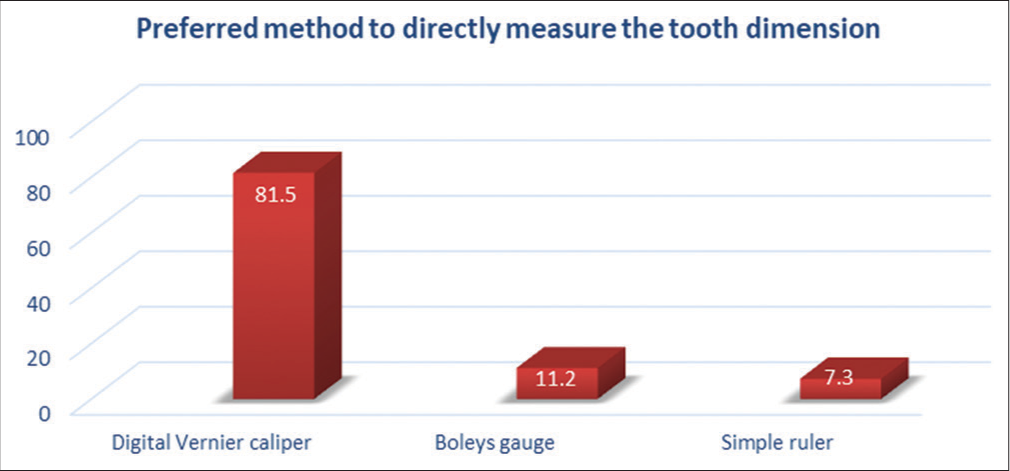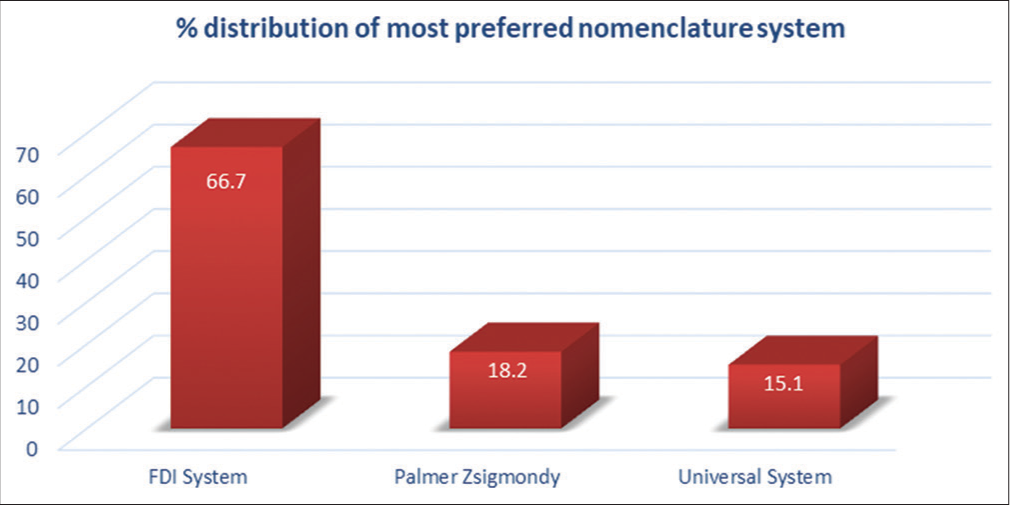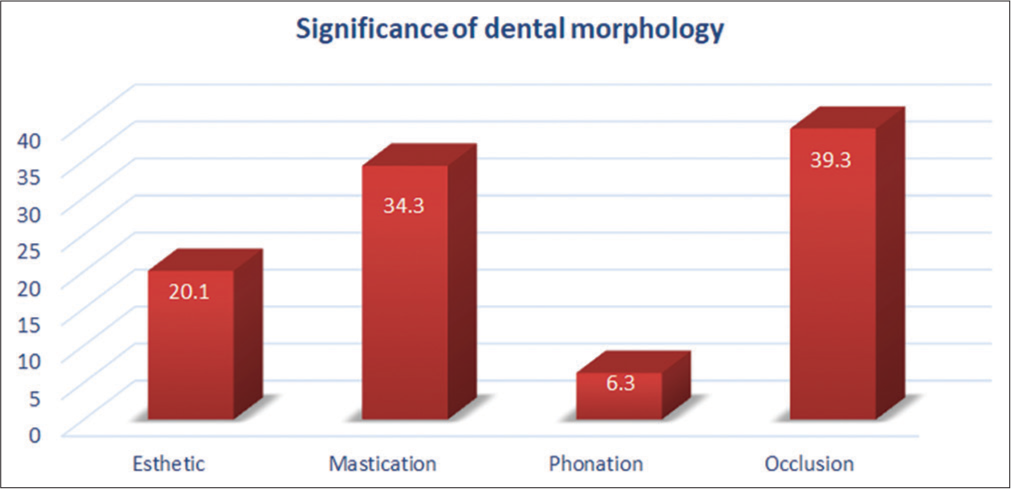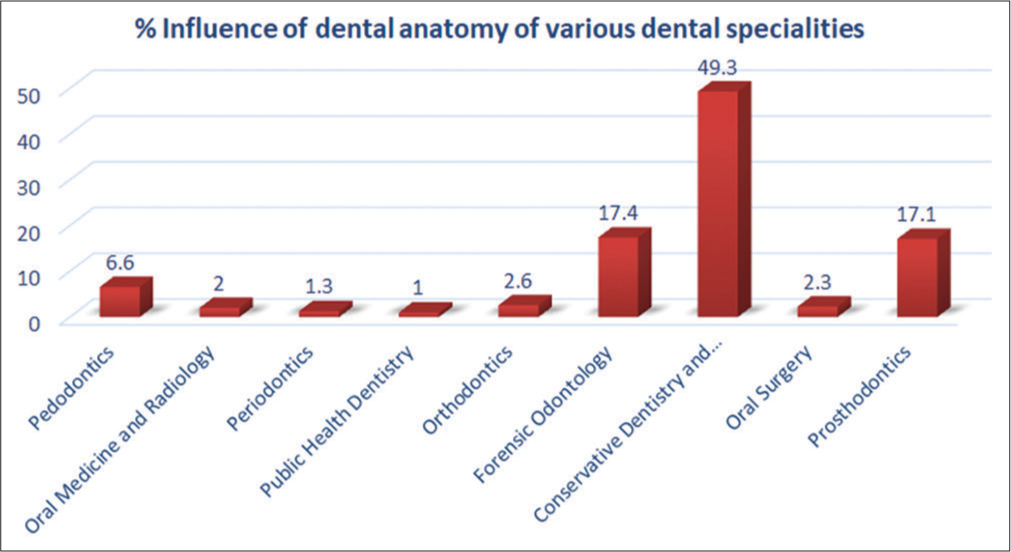Translate this page into:
Perception of dental anatomy among dental students, dental practitioners, and dental academicians: A questionnaire-based cross-sectional study

*Corresponding author: Divya Mandalaywala, Intern, Department of Oral Pathology, Government Dental College and Hospital, Ahmedabad, Gujarat, India. dhmandalay@gmail.com
-
Received: ,
Accepted: ,
How to cite this article: Mandalaywala D, Pillai JP, Monpara P, Gadhavi T. Perception of dental anatomy among dental students, dental practitioners, and dental academicians: A questionnaire-based cross-sectional study. J Acad Dent Educ 2022;8:9-14.
Abstract
Objectives:
The subject of dental anatomy is basically very important both from academic and practical points of view in dentistry. The present study was designed to determine the extent of variations in the perception of dental anatomy among dental students, dental practitioners, and dental academicians.
Material and Methods:
The questionnaire consisted of 15 closed-ended questions related to dental anatomy. There were 11 dichotomous questions with “yes” and “no” options and four multiple-choice questions. The questions were validated by experts and the questionnaire was submitted in Google form to the targeted respondent’s groups through WhatsApp and Emails. The responses received over 2 months were considered for statistical analysis. The Kruskal–Wallis non-parametric test was performed to test the difference in the responses between the groups of respondents.
Results:
The results of the study revealed that nearly 62–92% of the respondents gave an affirmative response to the dichotomous questions (Q. No. 1–11). The digital Vernier caliper was the most preferred instrument to measure the tooth dimensions and the FDI system was the most preferred nomenclature system among the respondents (66.7%) followed by the Palmer-Zsigmondy system (18.2%). Almost 50% of the respondents opted for conservative dentistry and endodontics as the clinical specialty in dentistry, where the knowledge of dental anatomy has its greatest application.
Conclusion:
There was no significant difference in the opinion about dental anatomy between the undergraduate dental students and the professionals except for their opinion regarding the course curriculum.
Keywords
Dental anatomy
Tooth morphology
Dental students
Dental practitioners
Dental academicians
Dental curriculum
Questionnaire-based study
INTRODUCTION
Dental anatomy is a branch of biology and a specialized field in anatomy that is concerned with the study of the tooth as an isolated entity and component of both dental and masticatory systems.[1] It is one of the core subjects taught during the 1st year of the undergraduate dental curriculum.[2] The development, appearance, and classification of teeth all come under the dental anatomy subject. Under the dental anatomy syllabus, tooth morphology, which deals with the study of the shape and forms of teeth, is one of the key basic concepts for the students to understand and develop over the course of their undergraduate training in dentistry. Knowledge of the tooth structures such as enamel, dentin, cementum, and pulp and their relation with each other is important to understand the basic dynamics of a tooth.[3] Dental anatomy involves practical and theoretical knowledge of both permanent and deciduous teeth and several anatomical landmarks of the oral cavity.[4] Dental students learn tooth morphology through didactic and practical sessions during the initial days of their dental curriculum. The basic knowledge of dental anatomy, thus, helps them during their clinical terms and in their clinical practice thereafter. Thorough knowledge of dental anatomy is not limited to an academic point of view but also serves a practical purpose in clinical dentistry. In a dental institute, the students are taught the didactic elements of types, forms, structures, nomenclatures, and identification of teeth. However, the perception of dental anatomy gained from an examination point of view during students’ life changes as practical and clinical experiences are gained. This is because, during the 1st year of the dental curriculum, the main focus is given to tooth carving and tooth identification. The tooth carving exercise not only helps the students to better understand the tooth morphology but also provides them with the new motor dexterity skills that are essential for the all the clinical dental procedures in their coming years. There are some gray areas such as the sexual dimorphism in tooth structures, the familial inheritance pattern in dental anatomy, and the racial or population variations in tooth structures are not given much importance. However, the perception of dental anatomy among several dentists may vary in actual clinical practice. The purpose of this study was to seek out the opinions of dental professionals, from students to practitioners and academicians regarding their perception of the usefulness of dental anatomy and their overall impressions of the subject in the dental curriculum.
MATERIAL AND METHODS
A questionnaire-based study on perception of dental anatomy among dental students, dental practitioners, and dental academicians was conducted [Figure 1]. A set of questions were prepared for this study and it was validated by two senior experts in the field. Later the questionnaire was prepared using Google forms through docs.google. com/forms and the link was emailed to the dental students, academicians, and practitioners groups across India. This study was conducted from August to October, 2021. After the set deadline, the gathered data were transferred to a Microsoft Excel spreadsheet. The questionnaire included 15 questions related to dental anatomy, 12 of which were dichotomous in nature [Table 1]. The respondents were categorized into four groups such as Group 1 – UG students, Group 2 – PG students, Group 3 – Dental Practitioners, and Group 4 – Dental Academicians. Data obtained from the survey were analyzed using SPSS software (Version 26) and conclusions were derived accordingly. The non-parametric Kruskal–Wallis test was used to compare the responses among the four respondent groups.

- Set of questions for this study.
| Questions | Kruskal-Wallis H | df | Sig. |
|---|---|---|---|
| 1. Do you feel dental anatomy taught in 1st BDS is or going to be helpful in actual clinical practice? | 3.212 | 3 | 0.360 |
| 2. Has the tooth carving from wax block in 1st BDS helped you understand the tooth morphology better? | 3.422 | 0.331 | |
| 3. Do you feel knowledge of dental anatomy forms the basis of other subjects in dentistry? | 3.952 | 0.267 | |
| 4. Do you feel the curriculum designed to learn dental anatomy in BDS is adequate? | 11.475 | 0.009 | |
| 5. Do you feel the anatomy of individual tooth plays an important role in defining the occlusion? | 1.619 | 0.655 | |
| 6. Do you think that the tooth morphology is bilaterally symmetrical in antimeres (same name tooth in same jaw) | 4.680 | 0.197 | |
| 7. Do you agree that tooth morphology exhibits sexual dimorphism (variations between genders)? | 3.563 | 0.313 | |
| 8. Do you agree that some dental morphology features vary among ethnic (racial) groups? | 0.855 | 0.836 | |
| 9. Do you think the uniqueness of dentition can effectively be used as a tool for identification in forensics? | 6.743 | 0.081 | |
| 10. Do you think there is familial inheritance pattern possible in tooth morphology/anatomy? | 3.083 | 0.379 | |
| 11. Do you think there is a need to keep the record of morphology and dimensions of the extracted tooth, before it is discarded? | 5.340 | 0.149 | |
| 12. Which method do you feel is the best tool to directly measure the tooth dimensions? | 1.692 | 0.639 | |
| 13. Which dental nomenclature system, you wish to follow in your practice? | 2.101 | 0.552 | |
| 14. According to you, the dental morphology has the maximum significant value in which of the following? | 2.650 | 0.449 | |
| 15. According to you in which of the following specialties other than oral pathology, the knowledge of basic tooth anatomy has its greatest influence | 5.770 | 0.123 |
RESULTS
A total of 303 respondents participated in the survey. The pie chart highlights the frequency distribution of the categories of the respondents based on their profiles [Figure 2]. There was a significant difference in the distribution of the responses for questions 1 to 11, which are dichotomous in nature [Figure 3]. Sixty-two to 92% of the respondents gave an affirmative response to these questions. Around 81% of the respondents preferred to use digital Vernier caliper for odontometrics [Figure 4]. The FDI system of nomenclature was the preferred method by 67% of the respondents followed by the Palmer Zsigmondy system [Figure 5]. Nearly 34% and 39% of the respondents opted for mastication and occlusion, respectively, for Q. No. 14 [Figure 6]. The phonation had the least significant value with dental anatomy according to the study. Almost 50% of the respondents considered conservative and endodontics as a specialty that has its greatest influence on dental anatomy followed by forensic odontology and prosthodontics [Figure 7]. The Kruskal–Wallis non-parametric test revealed a significant difference in the response to question no. 4 among the four groups of respondents [Table 1].

- Pie chart showing the distribution of respondents according to their profiles.

- Bar diagram showing the distribution of responses to question 1 to question 11.

- Bar diagram showing preferred method used to measure tooth dimension.

- Bar diagram showing the % distribution of the most preferred nomenclature system.

- Bar diagram showing the % distribution of responses for significance of dental morphology.

- Bar diagram showing the % influence of dental anatomy of various dental specialties.
DISCUSSION
The present survey was performed to assess the perception of dental students, academicians, and practitioners about dental anatomy and its importance in the dental curriculum. Nearly 62– 92% of the respondents gave an affirmative answer to all the questions in the questionnaire. The dental anatomy subject is taught during the preclinical phase of the dental curriculum in all dental institutes. In India, according to the dental council of India recommendations, a minimum of 355 h is allotted for teaching dental anatomy, embryology, and histology during the 1st year BDS curriculum. This includes 105 h of lecture sessions and 250 h of practical sessions.[5] During these sessions, the students acquire detailed knowledge about tooth morphology and also develop skills in tooth carving using wax blocks. They develop an ability in differentiating the deciduous and permanent teeth. The curriculum on dental anatomy is structured in such a way that the students can apply the basic knowledge during their clinical practice. Nearly 7% of the respondents felt that the skill in dental anatomy will not be useful during clinical practice. A study by Oweis et al. in Jordan reported that 80–88% of the students found the tooth morphology sessions like carving were useful in understanding the dental anatomy better.[6] In the present study, nearly 89% of the respondents agreed that tooth carving was important to understand dental anatomy. The results of the present study are also similar to the results of a study by Singh et al.[7] A similar study conducted among dental practitioners has revealed that more than 90% of the respondents agreed that an understanding of tooth morphology has helped them in clinical practice.[8] In a study by Nayak et al., 65% of the respondents believed that tooth carving helped them in their clinical skill and that too in the conservative dental practice.[9] Some authors feel that the carving of the root is unnecessary and more important needs to be given to the crown n portion of the tooth.[10,11]
In a study at the University of Aberdeen, the students felt that there is a need to further improve the dental anatomy curriculum and the tooth carving exercise has helped to develop their manual dexterity.[12] Advanced teaching aids such as the photorealistic 3D models of teeth and computer-assisted learning tools like Morpho Dent are also preferred methods of learning dental anatomy among the students.[13,14] Ninety percentage of the respondents agreed that tooth morphology influences occlusion. A study by Sierpinska et al. has proved that the occlusal morphology of premolars and molars has a great influence on the occlusion time.[15] In general, tooth proportions are not significantly different between the right and left sides.[16-18] More percentage of respondents opted for a negative response to question no. 6 when compared to other questions. Only 62% of the respondents thought that the ante-meres are bilaterally symmetrical. An earlier study comparing the distribution of the cusp numbers in antimeres has found around 77% symmetry in mandibular 2nd premolars.[19] Similarly, the mesiodistal and the buccolingual dimension of the mandibular 2nd premolar is also not significantly different between the right and left sides.[20] Teeth exhibit sexual dimorphism and this fact is well established through several studies in the past.[21-23] It was proved that the morphometric method was more appropriate in distinguishing the sexes in contrast to the photographic visual method.[24] There is a prediction probability of 59–68% using the odontometric methods.[25] In the present study, 85% of the respondents agreed that tooth exhibits sexual dimorphism. The existence of racial differences in the teeth was known to nearly 87% of the respondents. The extracted teeth usually find their destination in the solid waste bin. But not often does the dentist record the odontometric or the morphology details of the extracted tooth before discarding the same.[26] However, based on the present study, 83% of the respondents felt that there is a need to record the details of the extracted tooth before disposing them off. Further, such measures may generate a new set of data on tooth dimensions and also on the nonmetric details of different population subgroups. For recording such dimensions of a tooth, most of the respondents preferred to use the digital Vernier caliper (81.5%). The direct measurements made using the digital Vernier caliper may be comparable to the measurement done using digitally scanned models and software.[27] In the present study, the option of digital scanned models was not included in the study. Instead, the three common options from odontometrics were included in the study. Concerning the dental notation systems, most of the respondents preferred to use the FDI system followed by Palmer – Zsigmondy system. The Palmer notation is usually the preferred method in the UK and the main drawback of this system is that it is difficult to convert it to HTML format, the programming language of the internet.[28] The FDI World Dental Federation notation is widely used by dentists internationally.[29] It is also evident from the present study that most of the respondents preferred the FDI system of tooth nomenclature. As mentioned earlier, the dental anatomy subject forms the basic foundation for dentistry. In this survey, the dental morphology has its greatest significance in the occlusion and mastication functions. As students of dentistry, they are given much importance to the carving of the tooth structures with special emphasis on the occlusal morphology. During pre-clinical and clinical postings in prosthodontics, the students are taught about occlusion. In clinical practice too, the dentists are well aware of the importance of occlusion, may it be in a single tooth restoration or full-mouth rehabilitation cases. Around 20% of the participants felt that the tooth morphology is important for esthetics and only 6.3% of the participants opted for phonation choice. Almost half of the participants in this survey felt that knowledge and skill on dental anatomy have their greatest influence in practicing the conservative and endodontics specialty followed by forensic odontology specialty. Although forensic odontology is not well established as a separate subject in the undergraduate and postgraduate courses in dentistry in India, it is included in the UG curriculum as a part of oral pathology and oral medicine subjects.[30] In forensic odontology and forensic anthropology, the tooth dimensions and the non-metric parameters are being extensively researched for sex determination and ethnicity determination. Furthermore, the individual or unique dental morphological characteristics are used in forensic dental identification cases by comparing the antemortem and post-mortem dental findings. However, all the specialties in dentistry are applying the basic knowledge of dental anatomy in their practice. Hence, detailed and innovative teaching methodologies and a thorough understanding of the dental anatomy subject are the need of the hour.[31]
Advanced teaching methodologies such as the use of 3D models also need to be adopted while teaching. The dental curriculum may also include the dental non-metric traits and their variations among different populations in detail in practical sessions for the undergraduate and postgraduate students in dentistry.
CONCLUSION
Dental anatomy is one of the basic dental subjects in the dental curriculum. A questionnaire-based study on the perception of dental anatomy is presented here. The majority of the respondents gave an affirmative answer to all the questions related to dental anatomy knowledge and practice. However, the difference of opinion among the respondents is more with regard to the dental anatomy curriculum adequacy. Thus, based on this survey, a revision of the curriculum in dental anatomy with revised teaching methodologies in practical sessions is suggested by the authors.
Acknowledgment
We acknowledge all the dentists, students, professionals, and academicians who participated in the survey and have helped us carry a questionnaire-based survey.
Declaration of patient consent
Patient’s consent not required as there are no patients in this study.
Financial support and sponsorship
Nil.
Conflicts of interest
There are no conflicts of interest.
References
- Educational material of dental anatomy applied to study the morphology of permanent teeth. Braz Dent J. 2004;15:238-42.
- [CrossRef] [PubMed] [Google Scholar]
- Teaching clinically relevant dental anatomy in the dental curriculum: Description and assessment of an innovative module. J Dent Educ. 2011;75:797-804.
- [CrossRef] [PubMed] [Google Scholar]
- Educational interventions to improve dental anatomy carving ability of dental students: A systematic review. Anat Sci Educ. 2021;14:99-109.
- [CrossRef] [PubMed] [Google Scholar]
- Clinical significance of dental anatomy, histology, physiology, and occlusion. Sturdevants Art Sci Oper Dent. 2019;7:1-40.
- [CrossRef] [Google Scholar]
- Available from: https://dciindia.gov.in/Rule_Regulation/Revised_BDS_Course_Regulation_2007.pdf [Last accessed on 2021 Dec]
- Students' perceptions of dental anatomy course at the University of Jordan. Jordan Med J. 2015;49:147-54.
- [CrossRef] [Google Scholar]
- Perception of dental students about tooth carving in dental education at a tertiary level health care facility. Medico Legal Update. 2020;20:1493-9.
- [CrossRef] [Google Scholar]
- Knowledge, attitude and practice of tooth morphology among the dentists of Kathmandu. J Nepalese Prosthod Soc. 2019;2:17-21.
- [CrossRef] [Google Scholar]
- The perceived relevance of tooth carving in dental education: Views of practicing dentists and faculty in West India. Educ Health (Abingdon). 2014;27:238-42.
- [CrossRef] [PubMed] [Google Scholar]
- Root carving in tooth morphology is it really necessary? J Oral Maxillofac Pathol. 2021;25:22.
- [CrossRef] [PubMed] [Google Scholar]
- Self-directed study and carving tooth models for learning tooth morphology: Perceptions of students at the University of Aberdeen, Scotland. J Dent Educ. 2013;77:1147-53.
- [CrossRef] [PubMed] [Google Scholar]
- Introducing and evaluating MorphoDent, a Web-based learning program in dental morphology. J Dent Educ. 2010;74:1133-9.
- [CrossRef] [PubMed] [Google Scholar]
- A survey of tooth morphology teaching methods employed in the United Kingdom and Ireland. Eur J Dent Educ. 2018;22:e438-43.
- [CrossRef] [PubMed] [Google Scholar]
- The influence of occlusal morphology on occlusion time. Cranio. 2017;35:101-9.
- [CrossRef] [PubMed] [Google Scholar]
- Bilateral symmetry of anterior maxillary incisors: Evaluation of a community-based population. J Biol Regul Homeost Agents. 2017;31:37-43.
- [Google Scholar]
- CAD reconstruction using contralateral mirrored anterior teeth: A 3-dimensional metric and visual evaluation. Int J Prosthodont. 2008;21:521-3.
- [Google Scholar]
- Morphological symmetry of maxillary anterior teeth before and after prosthodontic planning: Comparison between conventional and digital diagnostic wax-ups. Med Princ Pract. 2016;25:276-81.
- [CrossRef] [PubMed] [Google Scholar]
- Novel application of the “Hardy-Weinberg equilibrium” in the analysis of cusp patterning phenotype in Gujarati Population. Forensic Sci Int Rep. 2019;1:100046.
- [CrossRef] [Google Scholar]
- Cusp number traits and the dental crown metric traits of mandibular premolars and maxillary second molar in sex determination: A cross-sectional dental model-based observational study. Int J Forensic Odontol. 2021;6:99-105.
- [CrossRef] [Google Scholar]
- Odontometric sex assessment in Indians. Forensic Sci Int. 2009;192:5.e1-5.
- [CrossRef] [PubMed] [Google Scholar]
- Sex discrimination potential of buccolingual and mesiodistal tooth dimensions. J Forensic Sci. 2008;53:790-2.
- [CrossRef] [PubMed] [Google Scholar]
- Tooth crown mesiodistal measurements for the determination of sexual dimorphism across a range of populations: A systematic review and meta-analysis. J Forensic Odontostomatol. 2019;37:2-19.
- [Google Scholar]
- Sexual dimorphism in teeth? Clinical relevance. Clin Oral Investig. 2012;16:395-9.
- [CrossRef] [PubMed] [Google Scholar]
- Determination of sexual dimorphism by odontometric study using discriminant function analysis of adult Ikwerre dental cast. Sch J Appl Med Sci. 2015;3:1732-8.
- [Google Scholar]
- "Odontometrics:" A need for anthropological data. J Forensic Dent Sci. 2018;10:59-60.
- [CrossRef] [PubMed] [Google Scholar]
- Validity, reliability and reproducibility of three methods used to measure tooth widths for Bolton analyses. Aust Orthod J. 2009;25:97-103.
- [Google Scholar]
- Sarjeev's supernumerary tooth notation system: A universally compatible add-on to the Two-Digit system. Indian J Dent Res. 2013;24:395-6.
- [CrossRef] [PubMed] [Google Scholar]
- Awareness of forensic odontology among dental students, academicians, and dental practitioners in Gujarat: A questionnaire based, cross sectional study. J Forensic Dent Sci 2020:28-40.
- [CrossRef] [Google Scholar]
- Need for innovative course module for teaching tooth morphology in India. J Oral Maxillofac Pathol. 2020;24:451-2.
- [Google Scholar]







